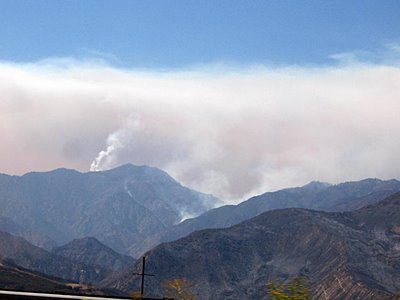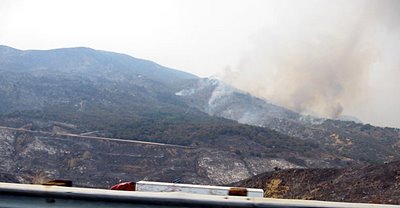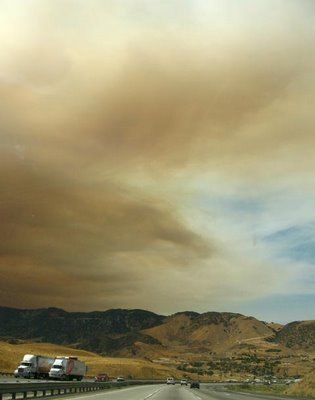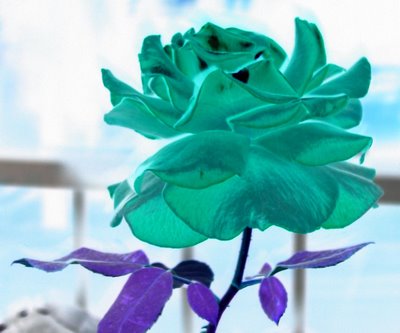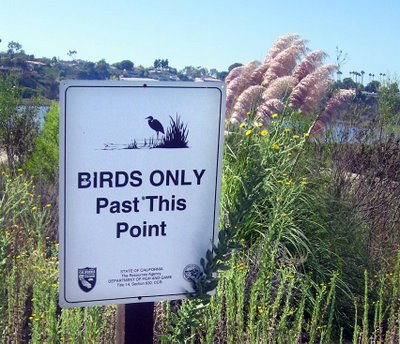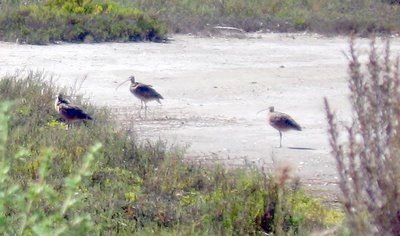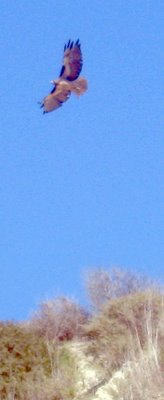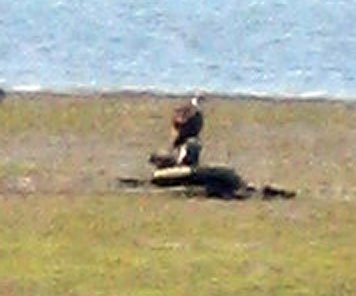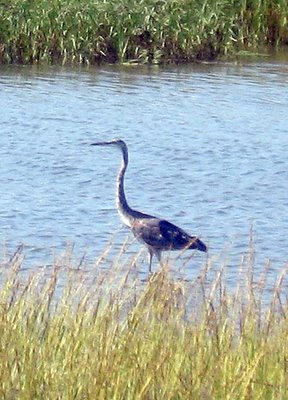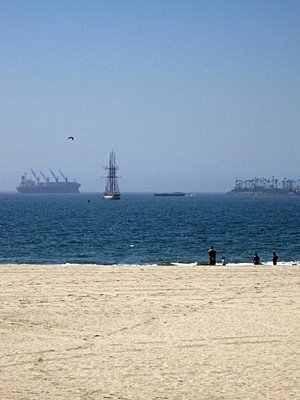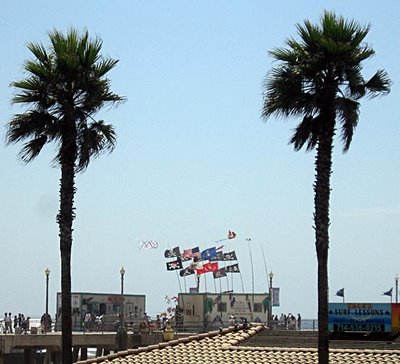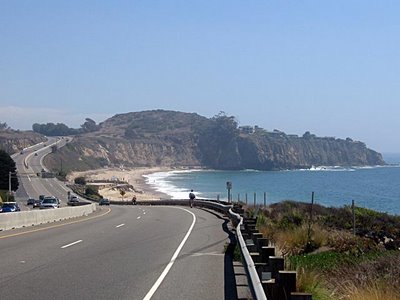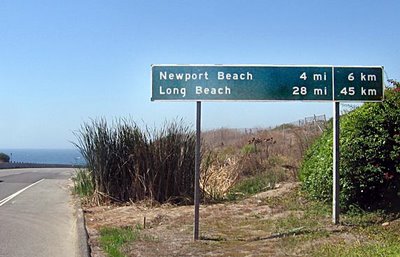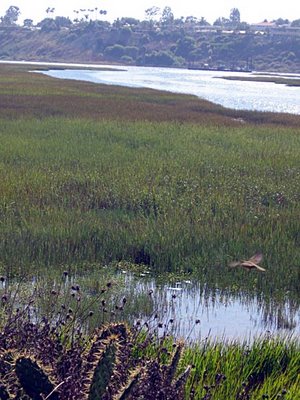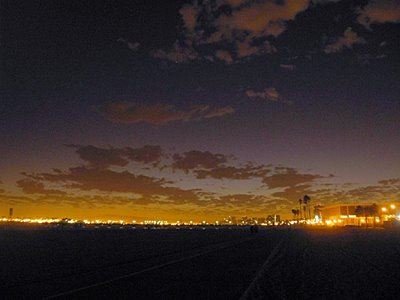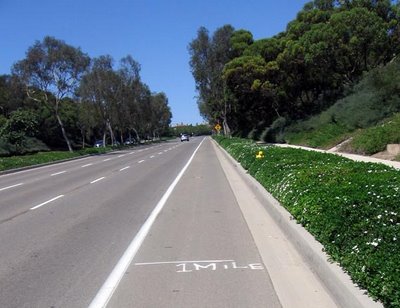
This hill is a lot steeper than it looks.
That "1 Mile" mark in the street is not what you want to see after huffing and puffing up a grueling grade. The joke is that it has nothing to do with cycling. I'm not sure what it marks, but it's not a mile from the top of the grade. The first time I rode this grade, a couple of days ago, I groaned when I saw the mark. I knew I was on a 2.5-mile leg, and I was
sure I was closer to the end. Turned out I was.
I went back and rode the identical course yesterday, because I enjoyed it so much on Saturday. Like many rides, it was mostly easier the second time through. I checked some numbers before I went, and made a significant flub in calculating this grade. I measured the leg from end to end, and checked the elevation at both ends, using Google Earth. The leg clocked out at 2.6 miles, starting at 129 feet and ending at 637 feet for a 508-foot climb. 508 feet in 2.6 miles is a 3.7% grade (3.7 feet of climb per 100 horizontal feet). No problem, I thought: Palos Verdes Drive East is a ±4% grade for 2.5 miles, so this is actually easier.
Uhm, I forgot one thing, which I remembered yesterday as I rode: The peak of this grade comes before the end of the riding leg. So I'd measured the grade as longer than it actually is, and I'd taken an elevation point significantly lower than the peak.
After I got home, I checked again. Google Earth confirmed that the actual peak was 722 feet, not 637. And the climbing part, from Pacific Coast Highway to the crest, is only 1.77 miles. The math on that works out to a 6.3% grade. Ah. That's why my legs felt so tired.
Palos Verdes Drive East, by comparison, tops out at a little over 800 feet, but the climb starts at a higher point than Newport Coast Drive, so there's only about 500 feet of climbing from the foot of the hill. That's spread over 2.5 miles instead of 1.77. Each ride has its peculiar challenges. Alpe d'Huez, one of the most famous crotch-busters in the Tour de France, runs 8 miles at 8%, an uninterrupted climb of 3,690 feet (1125m). This year it probably broke Floyd Landis.
He did well on the Alpe d'Huez, regaining the yellow jersey he'd "given away" some days before, but the next day his energy level broke down on the final climb of the day, and he lost several crucial minutes in the standings. What happened after that is still being litigated.
Take a look at the picture above, and you'll see there's not much cover from the sun on this hill either. Fun riding.
Actually, my legs would not have guessed this was a 6.3% grade. It's stiff climbing, but it doesn't feel that rough. I may go back and take a third look. Palos Verdes Drive East has lots of switchbacks, and the grade is not even, so you get harder spots and easier spots, and you can focus on what's right in front of you. Newport Coast Drive has long even stretches where you can look ahead, as in the picture above, and know that there's no break until at least the end of the current, very uniform, still punishing grade. Harder or easier mathematically, it's maybe more demoralizing in its way.
More numbers: Remember that sign from
the other day that said I was 28 miles from Long Beach? That would make a 56-mile round trip by bike; I estimated my turnaround point was maybe 5 miles past that, giving me roughly a 65-mile riding day.
I took a longer look at it in Google Earth, and it looks as if my turnaround point is more like 3.5 miles past that sign, adding 7 miles to the round trip. While I was at it, I studied another extra loop I took on the ride, and found I'd added 9.5 miles to the journey. Those are the major diversions from the route, so a seat-of-the-pants estimate is that my riding route was 56 + 7 + 9.5 miles, or 72.5 miles.
When I rode the same route again yesterday, with somewhat less stopping for pictures, from door to door my time was 6.5 hours. That means that, including stops, I averaged a bit over 11 miles an hour.
Funny thing is, when I rode a 100-mile route last month at about 13 m.p.h., I went back and looked at the individual legs and found I was typically running more like 15-16 m.p.h. What killed the average was the hills. I imagine a similar arithmetic applies here: I'm significantly slower on hills, and in this case also on the upwind return leg. I was coming home into a fairly stiff west wind yesterday, and my point-to-point time was slower than it had been two days before.
Speed factors into route plans. If I know how long it will take me to cover a certain amount of ground, I know I have to leave before a certain time if I want to get back before sunset, or before the afternoon wind kicks up, or before the dry cleaner closes. If I don't leave soon enough, I have to cut miles from the route. The beautiful thing about a long, lazy holiday weekend is that I can put off almost anything until later and just enjoy the ride.
Another set of numbers to keep the home crowd amused: With me on the ride I carried about 880 calories of nourishment, in various forms. A conservative estimate for bike riding is that the rider burns 500 calories per hour. In 6.5 hours, then, I probably burned at least 3,250 calories. When I got home, I quickly downed 360 calories of a "recovery" mix, but that still leaves me at a 2,010-calorie deficit.
This is why riders joke about the
pasta dinner at the end of the course. You start out the ride with a certain amount of calories in your blood sugar, which you go through, and a certain amount of additional energy available in your liver, which banks glycogen and adds it to the blood as you deplete what was there. Depending on the time of day, how much you've eaten, and how fast you're burning, you might count on your liver's "fuel tank" to keep your energy up for an hour or so of vigorous exercise. After that, you can either refill the tank with sports drinks that will hit the bloodstream quickly (sugar water, plus minerals you tend to lose in sweat) or you can, as a friend of mine put it, "start burning muscle." Actually, it's not that you burn your muscles; the body converts some fat too. But it takes a while to convert fat into energy, and you're burning energy at a higher rate. Your performance starts to drop and your energy flags noticeably.
In other words, after 6 hours on the road, you'll get home hungry.
For me, riding is not about weight loss; it's about fun and it's about cardiopulmonary fitness. But I'm not going to argue if I trim down some in the process. The typical calculation is that you'll lose a pound of body mass for every 3,500 calories burned and not replaced.
If I were in a hurry to slash pounds, I could take a ride like I did yesterday and deliberately not replenish my energy stores right away--force my body to convert what it's already carrying around. The downside of this (besides hunger and crankiness) is that it tends to leave me feeling sluggish and low-energy for the next 20 hours or so as my body very slowly rebalances my blood sugar. (I may not be quite precise on the biochemistry here, but you get the idea.) The effects are sometimes subtle, but over time you notice the difference in the way you behave. The next day, for example, you certainly wouldn't take another 70-mile ride. Your body would still be bouncing back. The muscle strength and speed would be there for a quick sprint, but the reserves that fuel long-distance stamina would be depleted. You'd have no "legs."
If nothing else were going on in the world, I could sit and do crossword puzzles until my energy returned, but on most days in my life it's a better idea to keep the vim and vigor (and mental energy) at full throttle. So I look at exercise as a weight-neutral proposition, not a weight-loss proposition. And if I lose a pound or two along the way, I don't complain.
So after my recovery drink, I'm still quite happy to sit down to about 1,000 calories of pasta and salad, and I know I won't be feeling as wiped out the next day.
And in fact, after a decent stretch of getting out regularly for some fresh air, I generally find my baseline energy level is higher from day to day.
There are plenty of other peripheral benefits, but the main idea is to have some fun.
Later on, when I'm not on my way to work, I'll post pictures from yesterday's ride. I'm not 100% sure, but I think I saw a bald eagle. Watch for updates.
